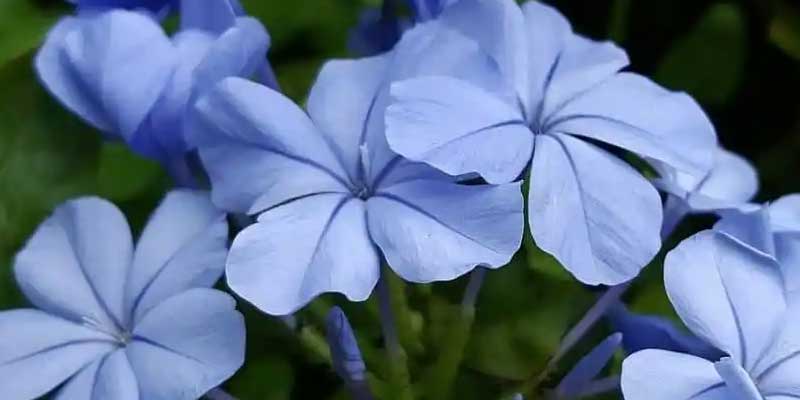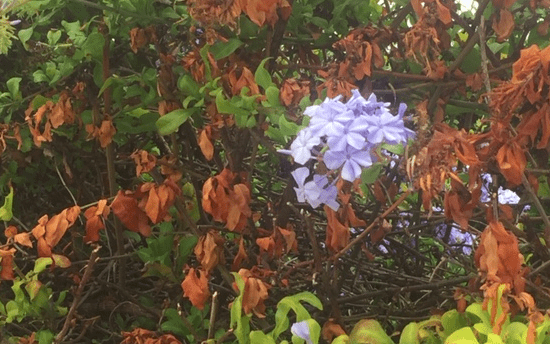Your plumbago plant is a beautiful addition to your garden, but lately you’ve been noticing that it’s been turning brown. What could be causing this, and more importantly, how can you fix it? In this blog post, we will discuss the possible causes of browning in plumbago plants and provide solutions to help get your plant back on track!

Why Are My Plumbago Leaves Turning Brown?
Brown leaves on plumbago leaves are usually caused by pests, fungal infections, overwatering, nutritional deficiency, and leaf burn. The browning on your plumbago leaves could be caused by any one of these factors, or a combination of them.
The exact solution for your plumbago will depend on the cause of the browning leaves. If pests are to blame, you’ll need to treat your plant with an insecticide. If overwatering is the problem, be sure to let the soil dry out between waterings. And if a nutrient deficiency is causing the leaves to turn brown, fertilize your plant with a balanced fertilizer.
Whatever the cause of your plumbago’s brown leaves, there is likely a solution that can help get your plant back to its beautiful self! I will now go over each possible cause of brown leaves in more detail, as well as the solutions for each.
1. Fungal Infection
If your plumbago leaves are turning brown and mushy, it’s likely that they have a fungal infection. The most common type of fungus that affects plumbago is powdery mildew. This can be treated with a fungicide, but it’s important to catch it early. If the infection has already spread, you may need to remove and destroy infected leaves.
To prevent powdery mildew, be sure to water your plumbago at the base of the plant rather than from above. This will help keep the leaves dry, which will make it harder for the fungus to take hold. You should also avoid crowding your plants, as this can promote fungal growth.
If you do find yourself with a powdery mildew problem, don’t despair! There are plenty of fungicides on the market that can help get your plant back to health. Neem oil (Amazon link) is my personal favorite, as it’s an all-natural solution that is also effective against pests.

2. Overwatering
Overwatering is one of the most common problems facing houseplants, and plumbago is no exception. If your plant is getting too much water, the leaves will start to turn brown and drop off.
The easiest way to tell if you’re overwatering your plumbago is to check the soil. If it’s constantly wet or mushy, that’s a sign that you’re giving your plant too much water.
First, stop watering it until the soil has a chance to dry out. Then, make sure you’re only watering when the soil is dry to the touch. And finally, be sure to empty any drainage trays so that your plant isn’t sitting in water.
3. Pests
Pests are another common problem that can cause plumbago leaves to turn brown. The most common pests that affect plumbago are aphids, whiteflies, and mealybugs. These pests suck the sap from the leaves, causing them to turn brown and eventually die.
To get rid of pests, you’ll need to treat your plant with an insecticide. I recommend using an all-natural solution like neem oil (Amazon link), as it’s effective and won’t harm your plants.
Once you’ve treated your plant, be sure to keep an eye out for pests and treat them immediately if they return. Prevention is better than cure, after all!
4. Leaf Burn
Leaf burn is a common problem with plumbago, and it’s usually caused by too much sun. If your plant is getting too much direct sunlight, the leaves will start to turn brown and curl up. This is a common occurrence in the spring and summer when the sun is at its strongest.
To prevent leaf burn, be sure to give your plumbago some protection from the sun. You can do this by planting it in a spot that gets partial shade or by covering it with a sheer curtain.
If your plant is already showing signs of leaf burn, it’s important to act fast! Move it to a shadier spot and give it some protection from the sun. The leaves should start to recover within a few days. However, the burnt tips won’t turn green gain.
5. Nutrient Deficiencies
If your plumbago is getting enough water but the leaves are still turning brown, it’s likely that there’s a nutrient deficiency. The most common nutrient deficiencies in plumbago are nitrogen and magnesium. These can be caused by poor soil quality or by using the wrong fertilizer.
To fix a nutrient deficiency, you’ll need to fertilize your plant with a balanced fertilizer. You can also add some compost to the soil to improve its quality. For promoting plumbago blooms, a 10-30-10 fertilizer is recommended by myself and many gardeners.
If you’re not sure what’s causing the nutrient deficiency, it’s best to take a sample of the soil to a gardening center for testing. They’ll be able to give you specific advice on how to fix the problem.
Will Brown Plumbago Leaves Turn Green Again?
No, it is unlikely. Once the leaves have turned brown, they will not turn green again. However, if you take care of the underlying problem, your plant should start to produce new growth that is green.
Should I Prune Brown Plumbago Leaves?
It depends on the cause of the brown plumbago leaves. If the problem is due to fungal diseases, then you may want to prune the affected leaves to prevent the disease from spreading. If the problem is due to pests or nutrient deficiencies, then you should not prune the leaves as this will further stress the plant.
Conclusion
In conclusion, there are several reasons why your plumbago might be turning brown. The most causes are overwatering, pests, leaf burn, and nutrient deficiencies. If you have brown plumbago, tackle the problem as soon as possible to prevent further damage. And remember, once the leaves have turned brown, they are unlikely to turn green again.
I hope this article was helpful in diagnosing the problem with your plumbago. If you have any questions or comments, please leave them below! Happy gardening!
Tim is an avid gardener from the UK. He was the founder of PlantCarer.com from 2021 to Sep 2023. He sold PlantCarer.com to Aaron. He has since started his own business called Seed To Supper, which provides new gardeners all the materials you need in a box (pots, seeds, compost and instructions) to grow your own delicious and nutritious vegetables and herbs from start to finish – no garden required.

My plum ego plants were producing a lot of flowers. I’m In North Central Florida, so I’m not yet worried of frost and I don’t overwater them. They are drying up and turning brown A few weeks ago I bought mulch (vigero) and I pulled some soil back, blended it with the mulch and worked it into the soil around each plant. Now two of them are drying up. What can I do? If it was fungus or pests would they all be doing that?